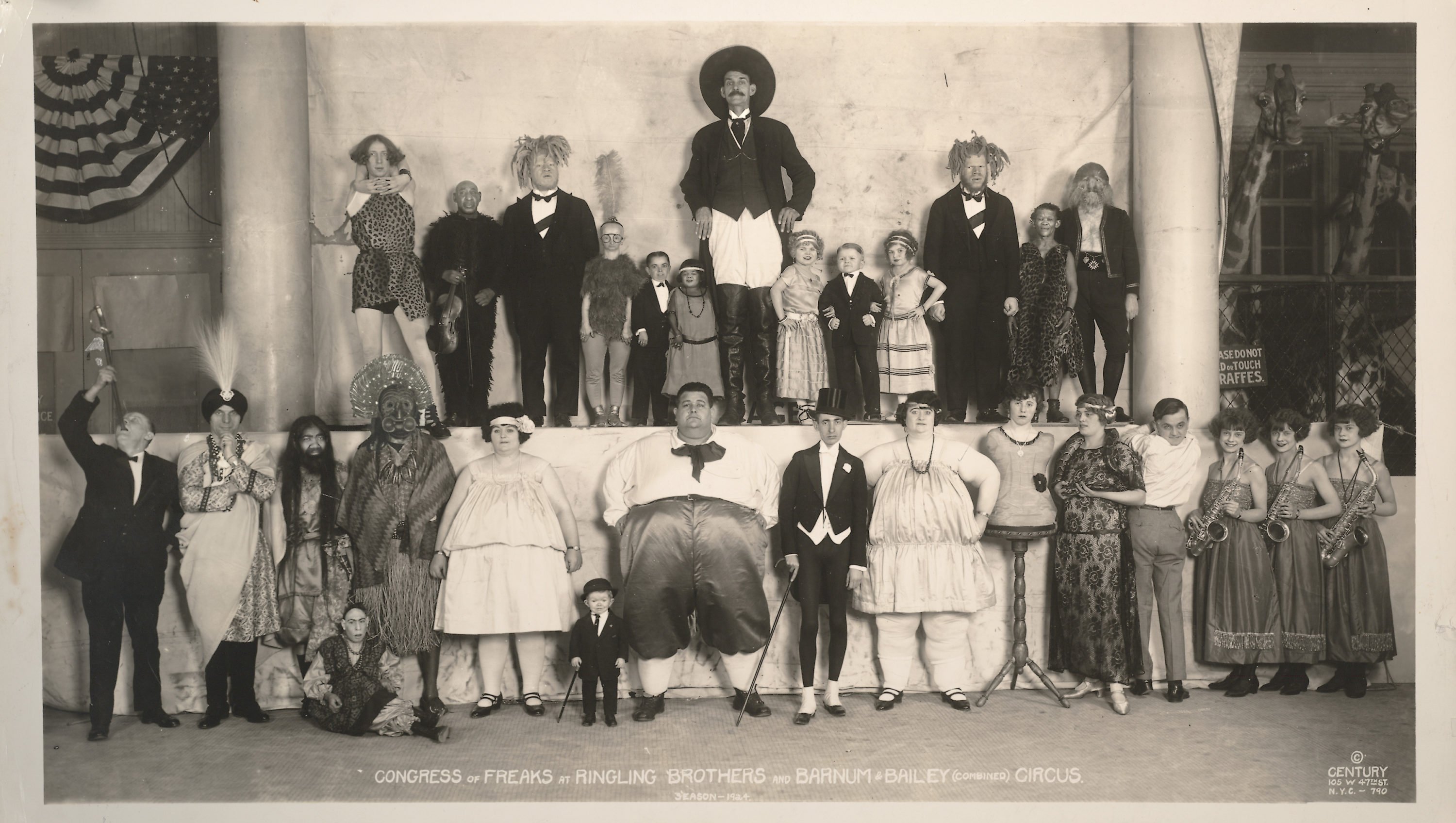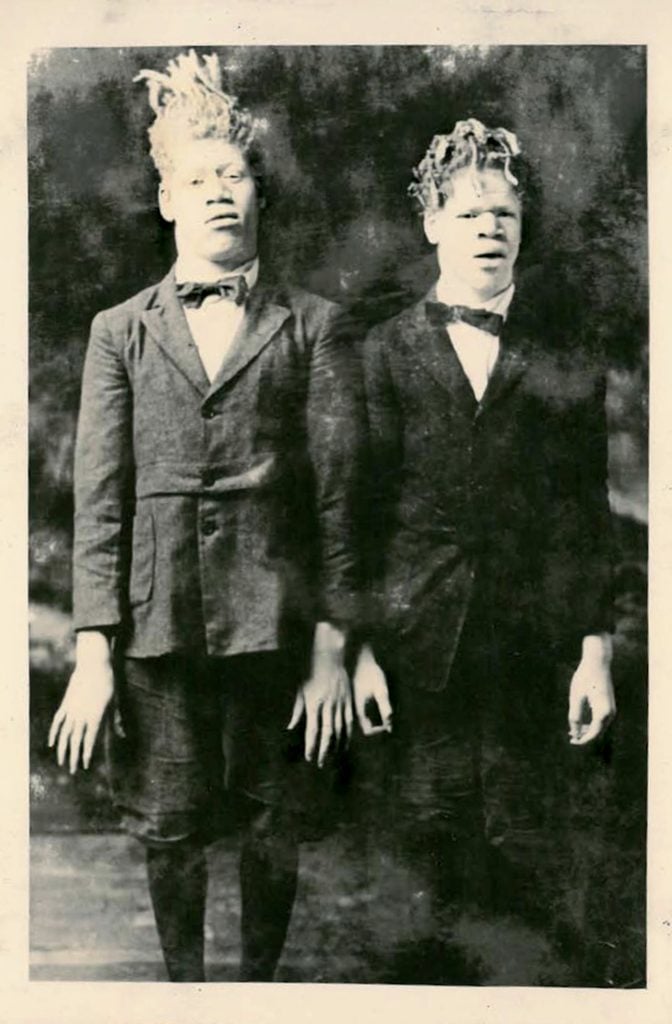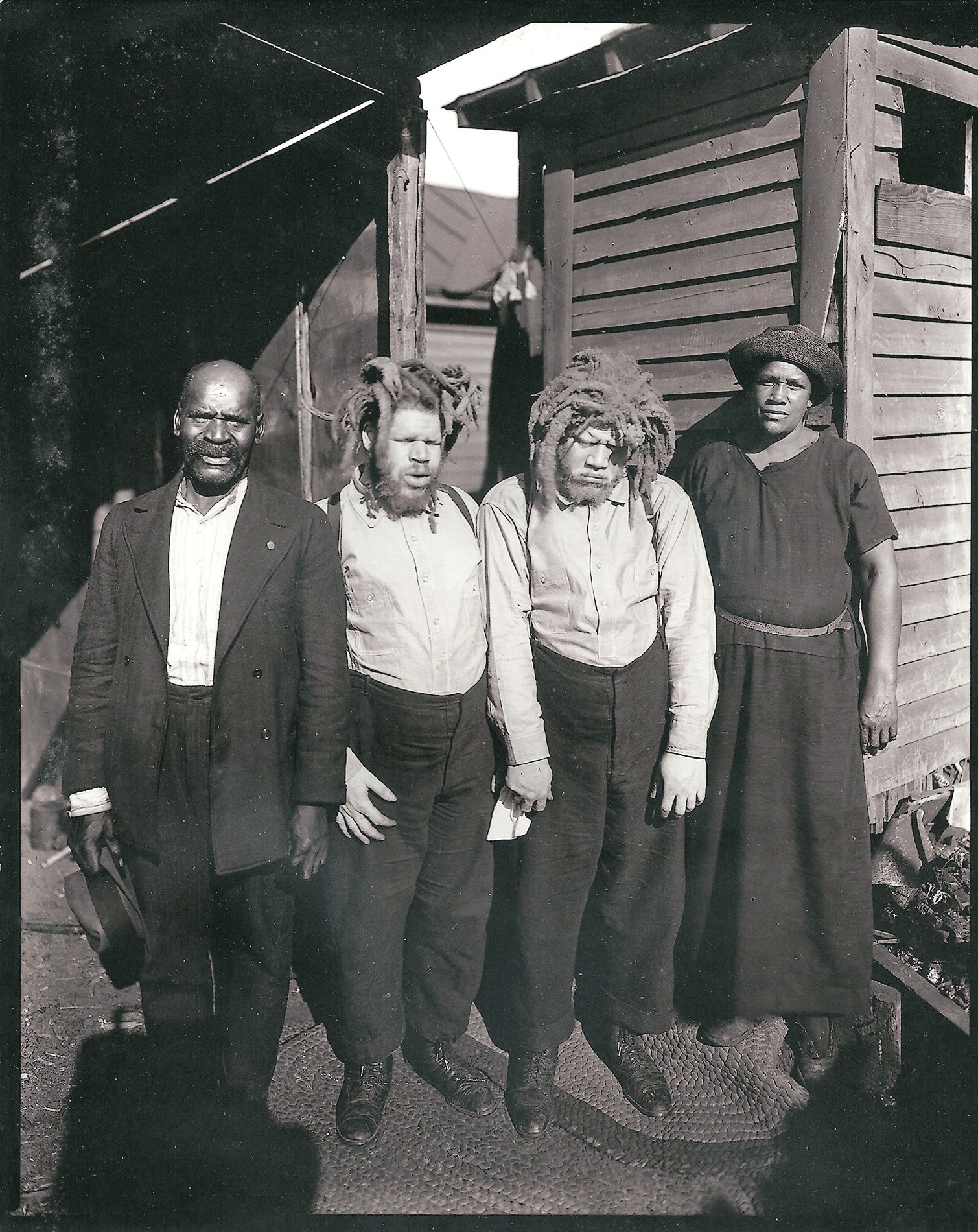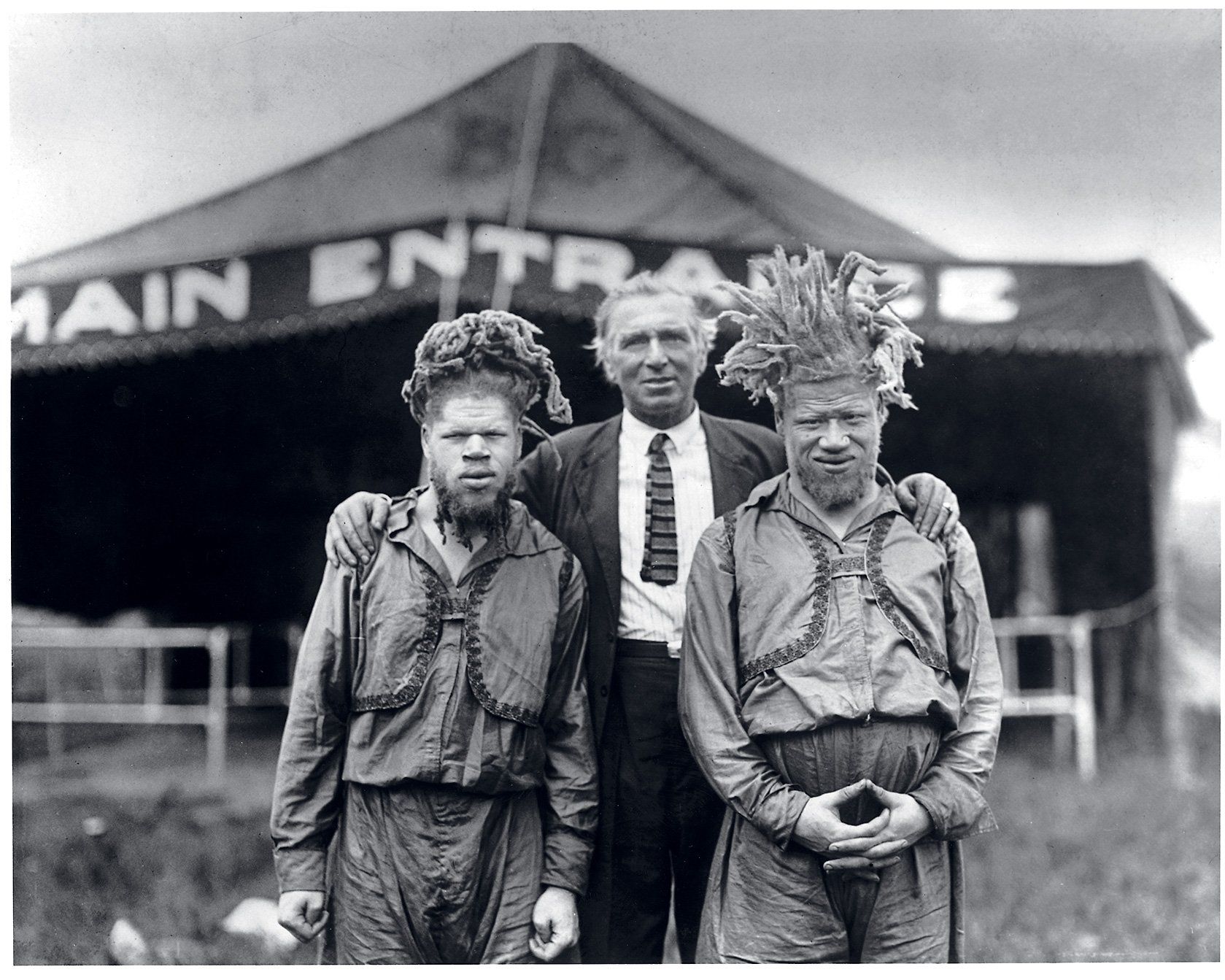Talk to any person of color over age 60 in my part of Virginia and they know the story by heart: Black children reared during the postwar baby boom rarely left home without being admonished by their mothers, “Y’all stay together now or you might be kidnapped, just like Eko and Iko.”
Eko and Iko were the sideshow stage names of George and Willie Muse, the grandsons of former slaves. They were born at the turn of the century to parents who sharecropped tobacco, like everyone else in the rural enclave of Truevine, Virginia.
George and Willie were just six and nine, as the elders tell the story, when a circus promoter crept onto the tobacco field where they were working and enticed them with a rare piece of candy. In the time it took to fetch a hoe from the shed, the boys vanished.
They were kidnapped in a dusty corner of southern Virginia named for the only thing that gave these Reconstruction-era blacks any semblance of hope—the biblical promise of a better life in the hereafter. “I am the true vine, and My father is the vinedresser,” Jesus said in the Gospel of John. “Every branch in Me that does not bear fruit He takes away; every branch that bears fruit He prunes, that it may bear more fruit.”
For the next 13 years, their mother, Harriett, watched and worried. And she waited for signs of fruit.
***
They were easy pickings for a traveling circus. The brothers were African-American albinos with watery blue eyes and blond hair, and their vision was poor, the result of an oscillating eye condition routinely misinterpreted as a mental deficiency.
In the late 19th century, the height of circus popularity, bounty hunters scoured America’s backwoods—and the world—looking for people they could transform into sideshow attractions. Acts such as Chang and Eng, the world’s most famous conjoined twins, “discovered” by a British merchant in Siam (now Thailand) in 1829. Or the Wild Men of Borneo, as impresario P.T. Barnum pitched a pair of dwarf brothers to audiences in 1880 . . . though they actually hailed from a farm in Ohio.
Somehow Barnum had heard about the albino brothers—maybe from a shopkeeper in nearby Rocky Mount, the county seat. Maybe a neighbor had seen the ads that showmen took out in newspapers and trade publications for “freak hunters,” as they were called.
Wanted — to hear from the man that grows three feet in front of your eyes . . . Call DAN RICE, Sioux City, Iowa.
Maybe even a member of their own family had given the boys up.

Although the timeline of the brothers’ earliest years is fuzzy, owing to illiteracy and uneven documentation, this much is certain: From 1914 to 1927, circus managers transformed the Muse brothers from scared little boys into world-famous sideshow freaks. George and Willie weren’t permitted to go to school or learn to read. They weren’t paid for their work. To stop them from begging to return home, they were told their mother was dead.
One day, a circus photographer handed them a banjo and guitar, telling them to pose with the instruments as photo props. It had to be a joke, their manager reasoned, that the strange-seeming brothers could ever learn the simplest of tunes. Little did he know that George and Willie harbored the innate ability to teach themselves almost any tune.
Though he was only three years older, George became Willie’s protector and his voice. George did most of the talking for the two, while Willie communicated mainly through his music. During World War I, they both took solace in the popular anthem “It’s a Long Way to Tipperary,” a song about missing home.
Sideshow operators dressed them in outlandish costumes and sculpted their hair into dreadlocks, shaped like sparklers exploding at the crown of their heads. They erected elaborate banners, alternately heralding the boys as “Barnum’s Original Monkey Men,” “the Ambassadors from Mars,” and “the Sheep-headed Men,” all the while spinning wild yarns about how the brothers had come to join the circus: They’d been discovered floating on a raft off the coast of Madagascar. Found in the Mojave Desert outside the remains of a Martian spaceship.
sideshow operators called them ‘barnum’s original monkey men,’ ‘ambassadors from mars,’ and ‘the shepherded men.’
As showman Al G. Barnes recalled in his 1936 memoir: “There was a story to the effect that the boys were members of a colony of sheep-headed people inhabiting an island in the South Seas; that they had been captured after many hair-raising escapes, and that they were the only specimens in captivity. The boys had a very low grade of intelligence, and the press-agent story fitted them well.”
But one after another, circus managers underestimated George and Willie Muse, who could hear a song just once and replicate it, by ear, on any instrument they were handed. Not just the guitar and banjo but the harmonica, saxophone, and xylophone, too.
More important, the showmen underestimated their mother, Harriett Muse, who’d moved to Roanoke not long after her sons’ disappearance. Destitute, illiterate, and soon to be widowed, she had relocated there seeking better-paying work as a maid, like so many sharecropping migrants—all the while never giving up hope that she would one day find her sons.
The answer finally came to Harriett in a dream, she told her family, in a story that’s been handed down from relative to relative until it’s all but fused into the family’s DNA.
The Greatest Show on Earth was making its way to Roanoke, and Harriett vowed: They could lynch her if they wanted, but one way or another, she was going to confront Ringling Brothers and Barnum & Bailey Circus, find her sons, and do everything she could to bring them home.
***
The day it happens, it’s the fall of 1927, a time when the city’s top law-enforcement officer is the founder of the local Ku Klux Klan and when Ringling executives travel with their own cadre of lawyers.
The bustling young railroad town has finally grown big enough to host the circus known as the Big One. By now, it has been 13 years since Harriett last laid eyes on her sons.
George and Willie can’t read the WELCOME TO ROANOKE sign as their train rolls through the mountains east from Bristol, past the crimson fall foliage and into the booming city. They probably recognize the topography of their childhood, though, as the sun rises and the train chugs through the red-clay hills where the Alleghenies meet the Blue Ridge. Past Poor Mountain, past Twelve O’Clock Knob, then past Fort Lewis until, finally, the train comes to a creaky halt in Roanoke, where Mill Mountain stands sentinel over the town.

The four-engine, five-ring behemoth arrives at 9 am on October 14. The tents and banners are hoisted, the animals disembark. Walking into the fairgrounds late that morning, George and Willie are as surprised as anybody to run into a familiar face.
It’s Leslie Craft Crawford, a neighbor from childhood. They haven’t seen her since then, not since they played together in Craigs Creek. But they recognize her immediately, exclaiming “Miss Leslie!” and waving their arms.
Surely it occurs to them how close they are to home: If Miss Leslie’s here, then maybe their mother is also nearby—assuming she’s alive.
Outside the tent, Harriett probably spies her sons’ banner picture first, though it’s doubtful she recognizes them from it, because showmen took pains to make them look neither albino nor black in the image but rather a garden-variety vanilla—the idea being that they wanted to “ward off an unpleasant or unfavorable reaction from the potentially racist general public,” as one historian put it.
The banner takes up prominent real estate, just to the right of the sideshow entrance—with a giant sign announcing continuous performances and topped by waving American flags. ARE THEY AMBASSADORS FROM MARS?, it says at the top, just to the left of the banner for Jolly Irene (real name Amanda Siebert), who at 620 pounds likely suffers from an untreated thyroid disorder.
Harriett Muse enters and finds her place near the back of the crowd as the inside lecturer wanders from one performer to the next, giving his spiel. As the audience follows him, she nudges her way toward the front.
The brothers, meanwhile, have taken their place on the sideshow stage, and when it’s time to introduce themselves and play the mandolin and guitar, they squint hard, their eyes scanning the standing, milling crowd. (As is typical with Ringling and other large circuses, there are no chairs inside the sideshow tent, making it the rare place in the circus where segregation codes often break down.)
The albinism has caused their vision to dim considerably in recent years, but if they squint just right, they can make out the faces near the front.
They sing their favorite song as they strum:
It’s a long way to Tipperary,
It’s a long way to go. . . .
George and Willie are halfway through it when their mother’s face comes hazily into focus. There are worry lines on her forehead, a deep crease between her brown, piercing eyes. She’s wearing a hand-sewn black dress, its collar cinched by a safety pin, a belt loose around her waist. Her dress is so long that it almost touches the tops of her creased, laceless shoes.
George spots her first and stops playing. He elbows his brother, in a scene the family will recount often, with pride, over the years.
“There’s our dear old mother,” George says. “Look, Willie, she is not dead.”
The crowd is puzzled when the brothers drop their personas, along with their instruments, and rush from the stage. They greet their mother, folding themselves into her tall, sturdy frame.
The band starts playing, but all the Dixieland jazz on the planet can’t cloud this astonishing reunion, this almost surreal instant in time. Before it’s over, a man named Candy Shelton appears, demanding to know: Who is this woman and why is she disrupting my show?
Harriett stands firm, clutching her sons. It’s dawning on her that he’s the man in charge, the one responsible for the trafficking of her sons. For the 13 years of family holidays, birthdays, and weddings that have passed without word of their health or whereabouts.
She will not leave the fairgrounds, she insists, unless George and Willie accompany her home.
But they’re Shelton’s children, he has the nerve to insist. They’re his property. He even has documents, somewhere, paperwork proving they have the same last name as he does!
A scrum of Ringling executives arrives to try to shore up Shelton’s claim, men in dark suits and fedoras—the people George and Willie have nicknamed City Hall.
The police are on their way, too.
The Ringlings are powerful people, they remind the maid—multimillionaires who have the ear of Presidents, their own railway lines, and mansions in several states.
Still, standing amid the sawdust in her dusty oxfords, Harriett refuses to budge. In an act of extraordinary defiance, a stance that could have easily landed her in jail, she doesn’t move when eight Roanoke police officers converge on the lingering, growing crowd, everybody eagerly listening and watching for her next move.
“They are my children!” she says.
It works. She convinces police officers to let them leave, as the newspaper describes it, with their “old mammy who yo all aint seen for all dese years,” awkwardly attempting to convey Harriett’s dialect without directly attributing it.
Even more astonishing, two days later, the tattered maid from Truevine will put on her best clothes, walk downtown, and hire an ambitious white lawyer to take on the Greatest Show on Earth.

For four generations, that was the story that was whispered and handed down through black families in Roanoke. It was as steeped in folklore as it was sullied by racist news accounts that dominated the Jim Crow–era press. It was accurate, but also incomplete.
The truth about what happened to the brothers in the intervening years was so raw that their relatives refused to talk about it. It took more than two decades of research before I understood that it was even more tangled—and more troubling—than what the old people knew.
In 1928, the Muse brothers returned to the circus, initially on their own terms. From Buckingham Palace to the islands of Hawaii, they performed alongside sword swallowers and giants and some of the Munchkins later cast in The Wizard of Oz. By the late 1920s, they were headline sideshow acts and star freaks, featured prominently in opening-day dispatches written from Madison Square Garden for the New York Times.
But for many years, Candy Shelton, their longtime circus manager, still called the shots, I discovered in long-buried court documents and circus archives and by interviewing some of Roanoke’s oldest citizens. Even after their mother’s 1927 lawsuit resulted in a settlement for their back wages and a labor contract, Shelton still skimmed their pay and controlled their every move.
During off-season visits home to see their relatives, he lingered menacingly beside them as they sat on their mother’s porch. “He hovered over ’em, like a person who was in charge,” one neighbor recalled. “So they wouldn’t run off. The circus owned ’em, you see.”
For decades, Harriett waged legal battles against Shelton and other sideshow managers to get her sons paid. Despite several rulings in their favor, it was a constant struggle to make sure they were compensated and the stipulations of the judicial rulings adhered to.
Because of their mother’s efforts, and her tenacity to hold the show managers accountable, the money sent back to Roanoke enabled her to buy a small farmhouse in the country and set the family on a path to financial stability that gradually drew them out of poverty.
When Harriett died of a heart attack en route to pick up her wartime sugar rations in 1942, the family buried her in an unmarked grave in a segregated cemetery. They paid off her property instead and made plans to buy a bigger, much nicer house—in town—for Willie and George.
The brothers returned to Roanoke for their mother’s funeral, this time without Shelton watching over them. Neighbor kids gathered afterward, trying to get a peep at their peculiar hair, their milky skin, their fluttering blue eyes.
“Mama’s gone,” George said, shaking his head.
“Mama’s gone,” Willie repeated, shaking his head.
***
On a warm fall day in 2015, I walked that cemetery with a Muse family relative and a burial-park caretaker, who pointed to the probable site of Harriett’s unmarked grave.
If you look closely down the row, he showed us, you could make out the indentations where the ground sinks in just so, the outline of the graves as straight and rectangular as a set of xylophone keys.
From “Truevine,” out this month. Copyright © 2016 by Beth Macy. Used by permission of Little, Brown and Company, New York. All rights reserved. Beth Macy, who lives in Roanoke, is also author of “Factory Man: How One Furniture Maker Battled Offshoring, Stayed Local—and Helped Save an American Town.” She can be reached through her website, AuthorBethMacy.com.
This article appears in our October 2016 issue of Washingtonian.













